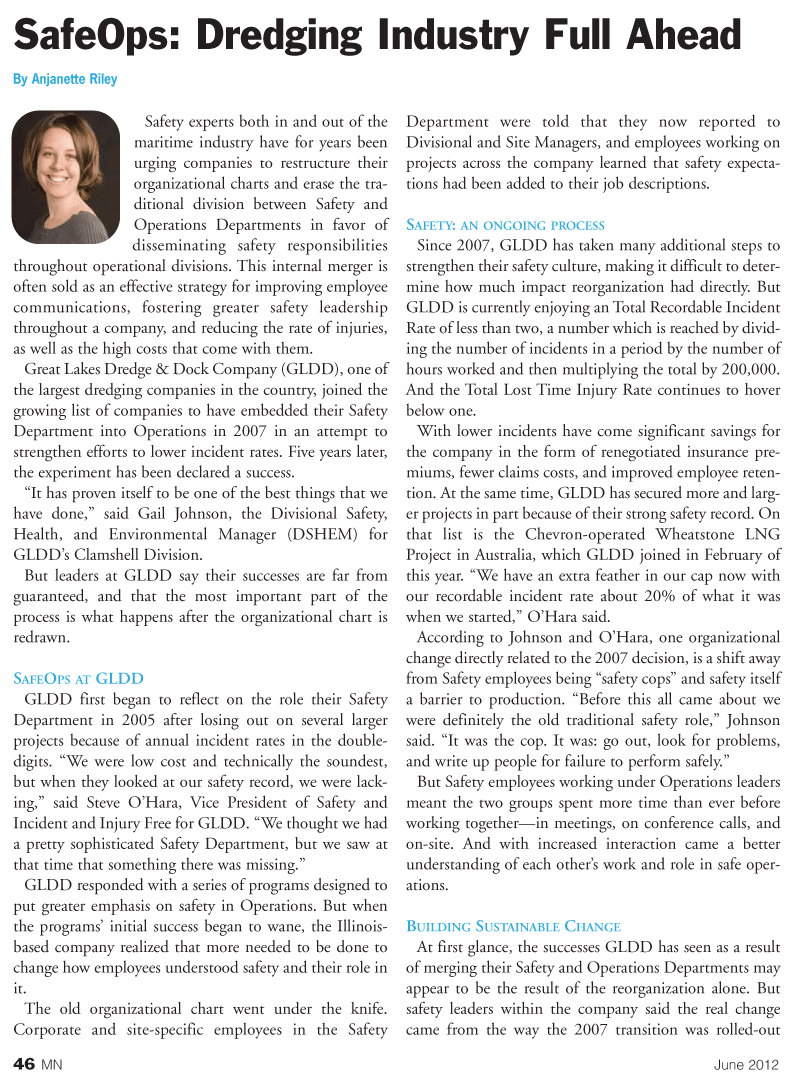
Page 46: of Marine News Magazine (June 2012)
Dredging & Marine Construction
Read this page in Pdf, Flash or Html5 edition of June 2012 Marine News Magazine
Safety experts both in and out of the maritime industry have for years been urging companies to restructure their organizational charts and erase the tra- ditional division between Safety and Operations Departments in favor of disseminating safety responsibilities throughout operational divisions. This internal merger is often sold as an effective strategy for improving employee communications, fostering greater safety leadership throughout a company, and reducing the rate of injuries, as well as the high costs that come with them. Great Lakes Dredge & Dock Company (GLDD), one of the largest dredging companies in the country, joined the growing list of companies to have embedded their Safety Department into Operations in 2007 in an attempt to strengthen efforts to lower incident rates. Five years later, the experiment has been declared a success. It has proven itself to be one of the best things that we have done,? said Gail Johnson, the Divisional Safety, Health, and Environmental Manager (DSHEM) for GLDDs Clamshell Division. But leaders at GLDD say their successes are far from guaranteed, and that the most important part of the process is what happens after the organizational chart is redrawn. SAFEOPSAT GLDDGLDD first began to reflect on the role their Safety Department in 2005 after losing out on several larger projects because of annual incident rates in the double- digits. We were low cost and technically the soundest, but when they looked at our safety record, we were lack- ing,? said Steve OHara, Vice President of Safety and Incident and Injury Free for GLDD. We thought we had a pretty sophisticated Safety Department, but we saw at that time that something there was missing.? GLDD responded with a series of programs designed to put greater emphasis on safety in Operations. But when the programs initial success began to wane, the Illinois- based company realized that more needed to be done to change how employees understood safety and their role in it. The old organizational chart went under the knife. Corporate and site-specific employees in the Safety Department were told that they now reported to Divisional and Site Managers, and employees working on projects across the company learned that safety expecta- tions had been added to their job descriptions. SAFETY : ANONGOINGPROCESS Since 2007, GLDD has taken many additional steps to strengthen their safety culture, making it difficult to deter- mine how much impact reorganization had directly. But GLDD is currently enjoying an Total Recordable Incident Rate of less than two, a number which is reached by divid- ing the number of incidents in a period by the number of hours worked and then multiplying the total by 200,000. And the Total Lost Time Injury Rate continues to hover below one. With lower incidents have come significant savings for the company in the form of renegotiated insurance pre- miums, fewer claims costs, and improved employee reten- tion. At the same time, GLDD has secured more and larg- er projects in part because of their strong safety record. On that list is the Chevron-operated Wheatstone LNG Project in Australia, which GLDD joined in February of this year. We have an extra feather in our cap now with our recordable incident rate about 20% of what it was when we started,? OHara said. According to Johnson and OHara, one organizational change directly related to the 2007 decision, is a shift away from Safety employees being safety cops? and safety itself a barrier to production. Before this all came about we were definitely the old traditional safety role,? Johnson said. It was the cop. It was: go out, look for problems, and write up people for failure to perform safely.? But Safety employees working under Operations leaders meant the two groups spent more time than ever before working together?in meetings, on conference calls, and on-site. And with increased interaction came a better understanding of each others work and role in safe oper- ations.BUILDINGSUSTAINABLE CHANGEAt first glance, the successes GLDD has seen as a result of merging their Safety and Operations Departments may appear to be the result of the reorganization alone. But safety leaders within the company said the real change came from the way the 2007 transition was rolled-out SafeOps: Dredging Industry Full Ahead By Anjanette Riley46MNJune 2012

 45
45

 47
47
